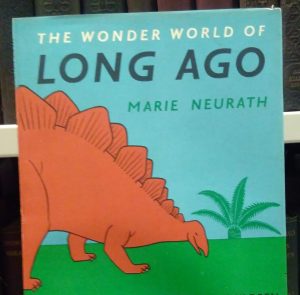Marie Neurath Collection
Reference: MARIE NEURATH COLLECTION Date: c. 1948-1971 Extent: c. 170 volumes
Marie Neurath (1898-1986) was a pioneer of graphic design who produced many educational children’s books.
She was born Marie Reidemeister in Braunschweig, Germany, and studied maths and physics at the University of Göttingen. In 1924, while still a student, she travelled to Vienna, where she first met Otto Neurath, her future husband and long-time collaborator.

Marie Neurath was the inspiration behind visually exciting information books for children from the end of the 1940s to the 1970s. She worked closely with Wolfgang Foges, Max Parrish, and others at the book-packaging company, Adprint, in the design and production of books in series including the ‘Visual History of Mankind’ (1947–63),’Wonders of the Modern World’ (1948–61), ‘The Wonder World of Nature’ (1952–62), ‘Visual Science’ (1950–60) and ‘They lived like this’ (1964–71).
In the 1920s, Marie Neurath was part of the team behind Isotype – the International System Of Typographic Picture Education – a method for assembling, configuring and disseminating statistical information through pictorial means. First known as the Vienna Method, it was developed by Otto Neurath and colleagues in 1920s Vienna, at the ground-breaking Gesellschafts- und Wirtschaftsmuseum (Museum of Society & Economy where pictorial charts helped to explain and illustrate contemporary social and economic issues to the general public. Marie Neurath’s responsibility in the making of the illustrative material was to analyse raw data and put it into picture form ready for final production by graphic artists and technicians. She was the principal ‘transformer’ and continued in this role on many projects from the 1920s until the early 1970s. Over time, the role of transformer broadened to encompass more than the interpretation of statistical information to include that of historical, technical or scientific concepts. In an account of her work, she explained the ingenuity, care and attention to detail that transformation involved. After Vienna, Marie worked with Otto Neurath in The Hague and escaped with him to England, where they were married in 1941. They moved to Oxford and set up the Isotype Institute. She continued as director of the Isotype Institute after Otto’s death (in 1945) and was a key player in writing and designing attractive and accessible books for children about nature, history, engineering, technology and science.
After Otto’s death, Marie moved from Oxford to London, where she continued her and Otto’s work on educational children’s books and remained until her death in 1986. In 1948, Max Parrish published the first of the Isotype Institute’s books for children. Max Parrish was Marie’s long-time editor for the years that followed. With a team of illustrators, Marie continued to work on Isotype children’s books for a further twenty years. The books themselves were mostly concerned with scientific subjects, but covered a range of topics, all in the distinctive Isotype style.
Overall, Marie and her team of illustrators produced more than 80 individual children’s books, most of which are in our collection. We also hold translations of Marie’s books in several languages.
THE OTTO AND MARIE NEURATH ISOTYPE COLLECTION
The books we hold are part of a larger collection, the Otto and Marie Neurath Isotype Collection, which is housed in the Department of Typography and Graphic Communication at the University of Reading. This collection is one of the main repositories of Otto and Marie Neurath’s work. In relation to the Isotype children’s books it contains preparatory material showing how the books were conceived, authored, designed and produced, as well as additional copies of the books. Digitised versions of the books are also available to enable access for researchers and visitors. For more information, and to see items from the Otto and Marie Neurath Isotype Collection, contact Emma Minns, Assistant Curator of the Lettering, Printing and Graphic Design Collections (e.h.minns@reading.ac.uk), or Eric Kindel, Curator of the Otto and Marie Neurath Isotype Collection (e.t.kindel@reading.ac.uk).
For information about Isotype see www.isotyperevisited.org
For more information on the Isotype children’s books, see www.marieneurath.org, a website from an exhibition at House of Illustration in 2019, curated by Sue Walker, Eric Kindel and Emma Minns.
MORE INFORMATION
- The Marie Neurath Collection is fully catalogued and searchable on the online catalogue.
- Read Professor Sue Walker’s detailed exploration of The first great inventions (1951), written as part of The MERL’s 70th anniversary project, 51 Voices.
ASSOCIATED COLLECTIONS
The Otto and Marie Neurath Isotype Collection in the Department of Typography & Graphic Communication